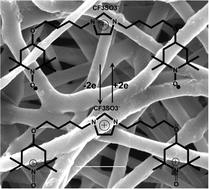In this study we report the synthesis and use of new organic materials, TEMPO di-radical [1,3-bis(4-(2,2,6,6,-tetramethyl-1-oxyl-4-piperidoxyl)butyl) imidazolium trifluorosulfonate]. Two cells were prepared with Li metal anode and the TEMPO di-radical based cathode with a microporous polymer electrolyte [1-butyl-3-methyl imidazolium bis(trifluoromethane sulfonyl) imide (BMImTFSI) in 0.5 M LiTFSI, and in 1 M LiPF6 in ethylene carbonate/dimethyl carbonate (EC/DMC)] hosted in electrospun poly(vinylidenefluoride-co-hexafluoropropylene) (PVdF-HFP) membrane. The nature of the solvent was not found to affect the basic redox reaction behavior of TEMPO. The anodic and cathodic peaks were obtained at almost the same position and with some difference in the separation of peaks. The presence of BMImTFSI significantly affects the electrochemical performance of the battery as the cell having this RTIL exhibited far better electrochemical performance with 100% utilization of the active material and reasonably good cycling performance up to 200 cycles. We believe that this composite cell will contribute to organic green rechargeable batteries, although the cell is not fully organic composite.

You have access to this article
 Please wait while we load your content...
Something went wrong. Try again?
Please wait while we load your content...
Something went wrong. Try again?


 Please wait while we load your content...
Please wait while we load your content...